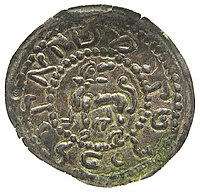Knaanic language
| Knaanic | |
|---|---|
| Region | Europe |
| Extinct | Late Middle Ages |
| Language codes | |
| ISO 639-3 | czk[note 1] |
czk | |
| Glottolog | west3000 |
Knaanic(also calledCanaanic,Leshon Knaan,Judaeo-Czech,Judeo-Slavic) is a tentative name for a number ofWest Slavicdialects or registers formerlyspoken by the Jewsin the lands of theWestern Slavs,notably theCzech lands,but also the lands of modernPoland,Lusatia,and otherSorbian regions.They became extinct in theLate Middle Ages.Very little is known about their difference from the surrounding Slavic languages. The largest number of samples of Knaanic written in Hebrew script are in Czech;[1][2]therefore, most commonly Knaanic is associated withOld Czech.
Etymology
[edit]The name comes from the "land of Knaan", a geo-ethnological term denoting the Jewish populations living principally in Czechia, though sometimes applied to all Jewish populations east of theElbeRiver (as opposed to theAshkenazi Jews,living to its west, or theSephardi Jewsof the Iberian Peninsula).[3]As such, the land is often translated as simplySlavoniaorSlavic Europe.[4]
The term is derived from ancientCanaan(Hebrew:כנען,kəna'an).
History
[edit]The language became extinct some time in theLate Middle Ages,possibly because of the expansion of theAshkenaziculture and its ownYiddish language,descended from earlyMiddle High German.That hypothesis is often backed by the large number of Yiddish loanwords of Slavic origin, many of which were no longer in use inSlavic languagesat the time of the Ashkenazi expansion. They are believed to come from Knaanic rather than fromCzech,SorbianorPolish.The linguistPaul Wexlerhas hypothesised that Knaanic is actually the direct predecessor of Yiddish and that the language later becameGermanised.[5]In other words, the Knaanim, that is, the people speaking the Judaeo-Slavic languages, were the main cause of changes in Yiddish.[6]That view has been dismissed by nearly all mainstream academics, however, and contrasts with the more widely accepted theories ofMax Weinreich,who argued that Slavic loanwords were assimilated only after Yiddish had already been fully formed.[7][8] The Jewish commentatorRashiwas aware of this language.[9]
Coinage
[edit]A possible early example of Knaanic is a 9th-century letter for a Jewish community ofRuthenia.[3]One of the very few commonly-accepted examples of Knaanic is inscriptions onbracteatecoins issued underMieszko the OldandLeszek the White,twoPolishrulers of 12th and 13th century. The last evidence of usage of the language (written with theHebrew script) comes from the 16th century.
The reason that Knaanic inscriptions, which use Hebrew letters, appear on coins minted for a Polish duke is that at the time, he leased some mints to Jews. The mint masters were responsible for collecting bullion and striking coins as well as periodically taking in and restriking existing coins.[10]
The inscriptions on the coins range widely. Some are Hebrew names, possibly those of the mintmasters. Some are the names of the towns in which the mint operated, for instanceKalisz,the burial place of Mieszko the Old. Some have the duke's name. One in theNational Bank of Poland's numismatic collection bears the wordbracha,Hebrew for blessing.[10]
| Inscription (Knaanic) | משקא קרל פלסק |
| Transcription | mškʾ krl plsk |
| Interpretation (Polish) | Mieszko, król Polski |
| Translation | 'Mieszko,king of Poland' |
Classification
[edit]In the 15th edition ofEthnologue(2005) assigned code czk to it and said that the termKnaanicis used primarily for Jewish Czech, possibly also for other Jewish variants of West Slavic languages, extinct in the Middle Ages. The 16th edition (2009) no longer listsKnaanicamong the West Slavic languages. It mentioned it only as an "extinct or artificial" language without further specification and refers to the Linguist List portal.
As of 2023[update]Ethnologueonce again lists Knaanic as a Czech–Slovak language.[11]
See also
[edit]- Judaeo-Spanish(Ladino)
Notes
[edit]- ^The iso639-3 page for czkhas no information on the language. It refers toEthnologue,Glottolog,Multitree,but only Ethnologue currently defines czk.
References
[edit]- ^Uličná, Lenka, "Roman Jakobson a staročeské glosy ve středověkých hebrejských spisech". Bohemica Olomucensia 3 – Filologica Juvenilia. Olomouc 2009, pp. 13-24,
- ^Uličná, Lenka, "Hlavní proudy středověkého (pre)aškenázského myšlení a tzv. pražská komentátorská škola. Hledání identity v podmínkách izolace a integrace". In: Jiřina Šedinováet al,Dialog myšlenkových proudů středověkého judaismu,Praha, 2010
- ^abvarious authors;Szymon Datner(1983). Witold Tyloch (ed.).Z dziejów Żydów w Polsce(in Polish). Warsaw: Interpress. p. 6.ISBN83-223-2095-7.
- ^Max Weinreich;Paul Glasser;Shlomo Noble;Yivo Institute for Jewish Research(corporate) (January 2008).History of the Yiddish Language.Vol. 1. New Haven:Yale University Press.p. 525.ISBN978-0-300-10887-3.
- ^Paul Wexler (2002).Two-tiered relexification in Yiddish: The Jews, Sorbs, Khazars and the Kiev-Polessian dialects.Berlin: Mouton de Gruyter.ISBN3-11-017258-5.
- ^Mark Louden (2000). "Contact-induced phonological change in Yiddish: Another look at Weinreich's riddles".Diachronica.17(1). John Benjamins Publishing Company: 85–110.doi:10.1075/dia.17.1.05lou.
- ^for instanceMax Weinreich (1956). "Yiddish, Knaanic, Slavic: The basic relationships".ForRoman Jakobson:Essays on the occasion of his sixtieth birthday, 11 October 1956.The Hague: Mouton. pp. 622–632.
- ^History of the Yiddish Language,op.cit., pp. 727
- ^"Rashi on Deuteronomy 3:9:2".
- ^abBankoteka,p.25.
- ^"Indo-European - Ethnologue Free".Ethnologue.SIL International.Archivedfrom the original on 2023-05-22.Retrieved2023-05-21.
Literature
[edit]- Bondyová, Ruth (2003).Mezi námi řečeno. Jak mluvili Židé v Čechách a na Moravě[Between us: language of Jews in Bohemia and Moravia] (in Czech). Society of Franz Kafka].ISBN80-85844-88-5.The book documents languages used by Jews in the Czech lands during 12–20th century.Reviewin Czech, pages 28–33.
- (In Czech)Šedinová, Jiřina:"Literatura a jazyk Židů v Českých zemích",inEUROLITTERARIA & EUROLINGUA2005, Technická univerzita v Liberci, Liberec 2005. Jiřina Šedinová from the Charles University in Prague seems to be the only specialist to study the glosses written inleshon kenaanwhich appear in some Jewish religious texts from Bohemia. In this article the author affirmsleshon kenaanis just the Hebrew term for the local Slavic language.
- Max Weinreich,History of the Yiddish Language,1980,ISBN0-226-88604-2
External links
[edit] Media related toKnaanic languageat Wikimedia Commons
Media related toKnaanic languageat Wikimedia Commons


